Fig. shows a metal rod PQ resting on the rails A, B and positoned between the poles of a permanent magnet. The rails, the rod and the magnetic field are in three mutually perperdicular directions. A galvanometer connects the rails through a switch K. Length of the rod = 15 cm, B = 0.50 T, resistance of closed loop containing the rod =9.0mΩ Answer the following questions.
(a) Suppose K is open and the rod moves with a speed of 12cm/s in the direction shown, Give the polarity and magnitude of induced e.m.f
(b) Is there on excess charge built up at the ends of rods when K is open ? What if K is closed ?
(c ) With K open and the rod moving uniformly, there is no net force on the electron in the rod PQ even though they do experience magnetic froce due to the motion of the rod Explain.
(d) What is the retarding force on the rod when K is closed?
(e) How much powe s required (by an external agent) to keep the rod moving at the same speed (=12cm/s) when K is closed. (f) How much power is dissipated as heat in the closed circuit ? What is the source of this power?
(g) What is the induced e.m.f. in the following in the moving rod when the permanent magnet is rotated to a vertical position so that the field is parallel to the rails instead of being perpendicular ?
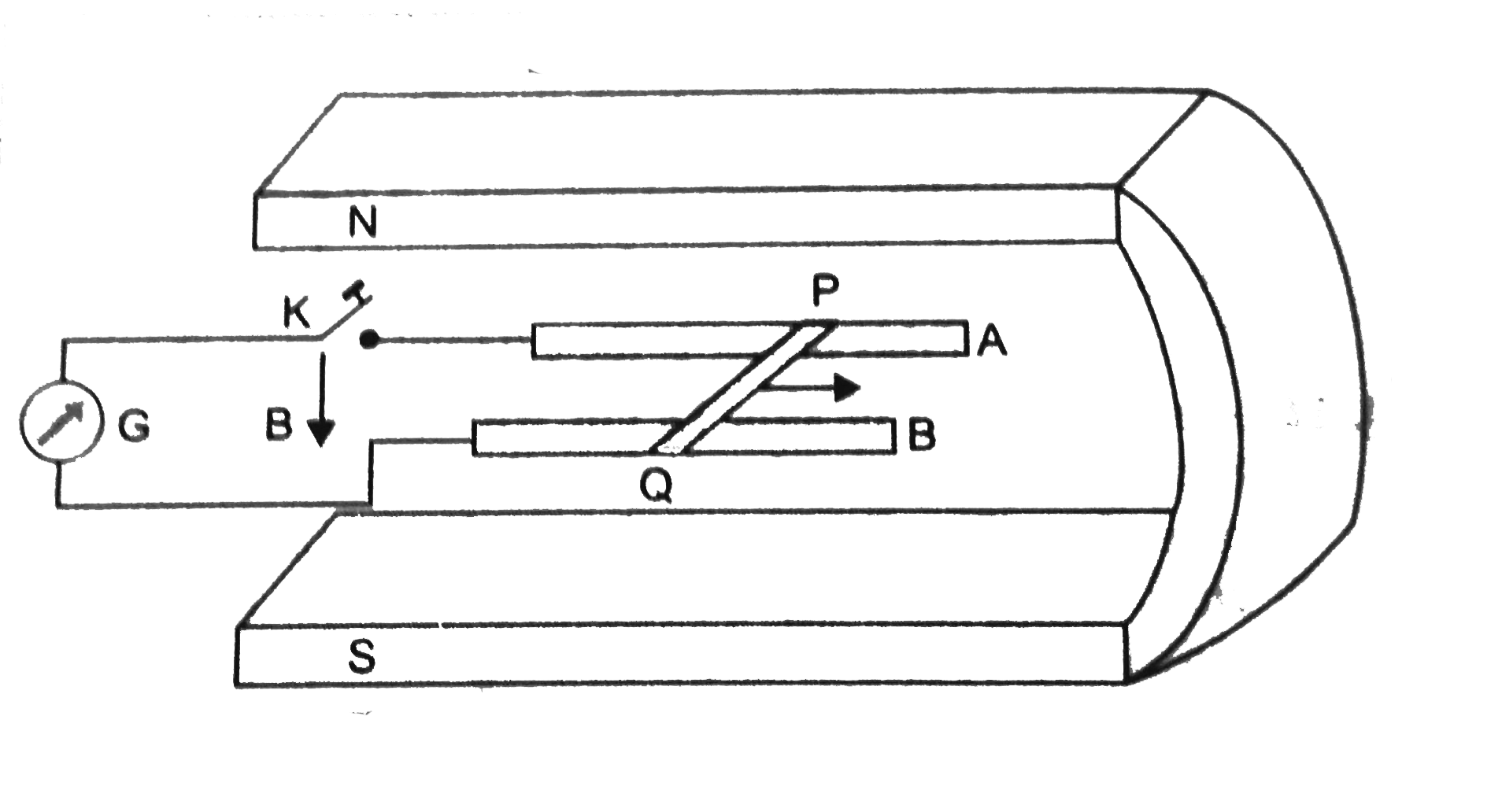
Step by step video & image solution for Fig. shows a metal rod PQ resting on the rails A, B and positoned between the poles of a permanent magnet. The rails, the rod and the magnetic field are in three mutually perperdicular directions. A galvanometer connects the rails through a switch K. Length of the rod = 15 cm, B = 0.50 T, resistance of closed loop containing the rod = 9.0 m Omega Answer the following questions. (a) Suppose K is open and the rod moves with a speed of 12 cm//s in the direction shown, Give the polarity and magnitude of induced e.m.f (b) Is there on excess charge built up at the ends of rods when K is open ? What if K is closed ? (c ) With K open and the rod moving uniformly, there is no net force on the electron in the rod PQ even though they do experience magnetic froce due to the motion of the rod Explain. (d) What is the retarding force on the rod when K is closed? (e) How much powe s required (by an external agent) to keep the rod moving at the same speed ( = 12 cm//s) when K is closed. (f) How much power is dissipated as heat in the closed circuit ? What is the source of this power? (g) What is the induced e.m.f. in the following in the moving rod when the permanent magnet is rotated to a vertical position so that the field is parallel to the rails instead of being perpendicular ? by Physics experts to help you in doubts & scoring excellent marks in Class 12 exams.
Updated on:21/07/2023Topper's Solved these Questions
Similar Questions
A cell of emf 2 V and internal resistance 1Ω has its terminals joined by resistanecs of 5 and 10Ω in paralle. Using kirchhoff's laws, find the current through the cell and the current drawn through each resistance.
View SolutionHow would you establish an instantaneou displacement current of 2.0A in the space between the parallel plates of 1μF capacitor?
View SolutionFollowing figure shows a metal rod PQ resting on the smooth ralls AH and positioned between the poles of a permanent magnet. The rails, the rod and the magnetic field are in three mutual perpendicular directions. A galvanometer G connects the rails through a switch K. Length of the rod 15 cm, B 0.50 T, resistance of the closed loop containing the rod 9.0 mOmega . Assume the field to be uniform. Suppose K is open and the rod is moved with a speed of 12"cm s"^(-1) in the direction shown. Give the polarity and magnitude of the induced emf.
View SolutionFollowing figure shows a metal rod PQ resting on the smooth ralls AH and positioned between the poles of a permanent magnet. The rails, the rod and the magnetic field are in three mutual perpendicular directions. A galvanometer G connects the rails through a switch K. Length of the rod 15 cm, B 0.50 T, resistance of the closed loop containing the rod 9.0mΩ. Assume the field to be uniform.
Is there an excess charge built up at the ends of the rods when K is open? What if K is closed?
View SolutionFollowing figure shows a metal rod PQ resting on the smooth ralls AH and positioned between the poles of a permanent magnet. The rails, the rod and the magnetic field are in three mutual perpendicular directions. A galvanometer G connects the rails through a switch K. Length of the rod 15 cm, B 0.50 T, resistance of the closed loop containing the rod 9.0 mOmega . Assume the field to be uniform. With K open and the rod moving uniformly, there is no net force on the electrons in the rod PQ even though they do experience magnetic force due to the motion of the rod. Explain.
View SolutionFollowing figure shows a metal rod PQ resting on the smooth ralls AH and positioned between the poles of a permanent magnet. The rails, the rod and the magnetic field are in three mutual perpendicular directions. A galvanometer G connects the rails through a switch K. Length of the rod 15 cm, B 0.50 T, resistance of the closed loop containing the rod 9.0 mOmega . Assume the field to be uniform. What is the retarding force on the rod when K is closed?
View SolutionFollowing figure shows a metal rod PQ resting on the smooth ralls AH and positioned between the poles of a permanent magnet. The rails, the rod and the magnetic field are in three mutual perpendicular directions. A galvanometer G connects the rails through a switch K. Length of the rod 15 cm, B 0.50 T, resistance of the closed loop containing the rod 9.0mΩ. Assume the field to be uniform.
How much power is required (by an external agent) to keep the rod moving at the same speed (=12 cm s−1) when K is closed ? How much power is required when K is open?
View SolutionFollowing figure shows a metal rod PQ resting on the smooth ralls AH and positioned between the poles of a permanent magnet. The rails, the rod and the magnetic field are in three mutual perpendicular directions. A galvanometer G connects the rails through a switch K. Length of the rod 15 cm, B 0.50 T, resistance of the closed loop containing the rod 9.0mΩ. Assume the field to be uniform.
How much power is dissipated as heat in the closed circuit ? What is source of this power?
View SolutionFollowing figure shows a metal rod PQ resting on the smooth ralls AH and positioned between the poles of a permanent magnet. The rails, the rod and the magnetic field are in three mutual perpendicular directions. A galvanometer G connects the rails through a switch K. Length of the rod 15 cm, B 0.50 T, resistance of the closed loop containing the rod 9.0mΩ. Assume the field to be uniform.
What is the induced emf in the moving rod if the magnetic field is parallel to the rails instead of being perpendicular?
View Solutionचित्र में एक धातु की छड़ PQ को दर्शाया गया है जो पटरियों AB पर रखी है तथा एक स्थायी चुम्बक के ध्रुवो के मध्य स्थित है । पटरियाँ , छड़ एवं चुंबकीय क्षेत्र परस्पर अभिलंबवत दिशाओ में है ।एक गैल्वेनोमीटर ( धारामापी ) G को पटरियों से एक स्विच K की सहायता से संयोजित किया गया है । छड़ की लम्बाई 15 सेमी , B = 0.50 T तथा पटरियों , छड़ धारामापी से बने बंद लूप का प्रतिरोध = 9.0mΩ है । क्षेत्र को एकसमान मान ले ।
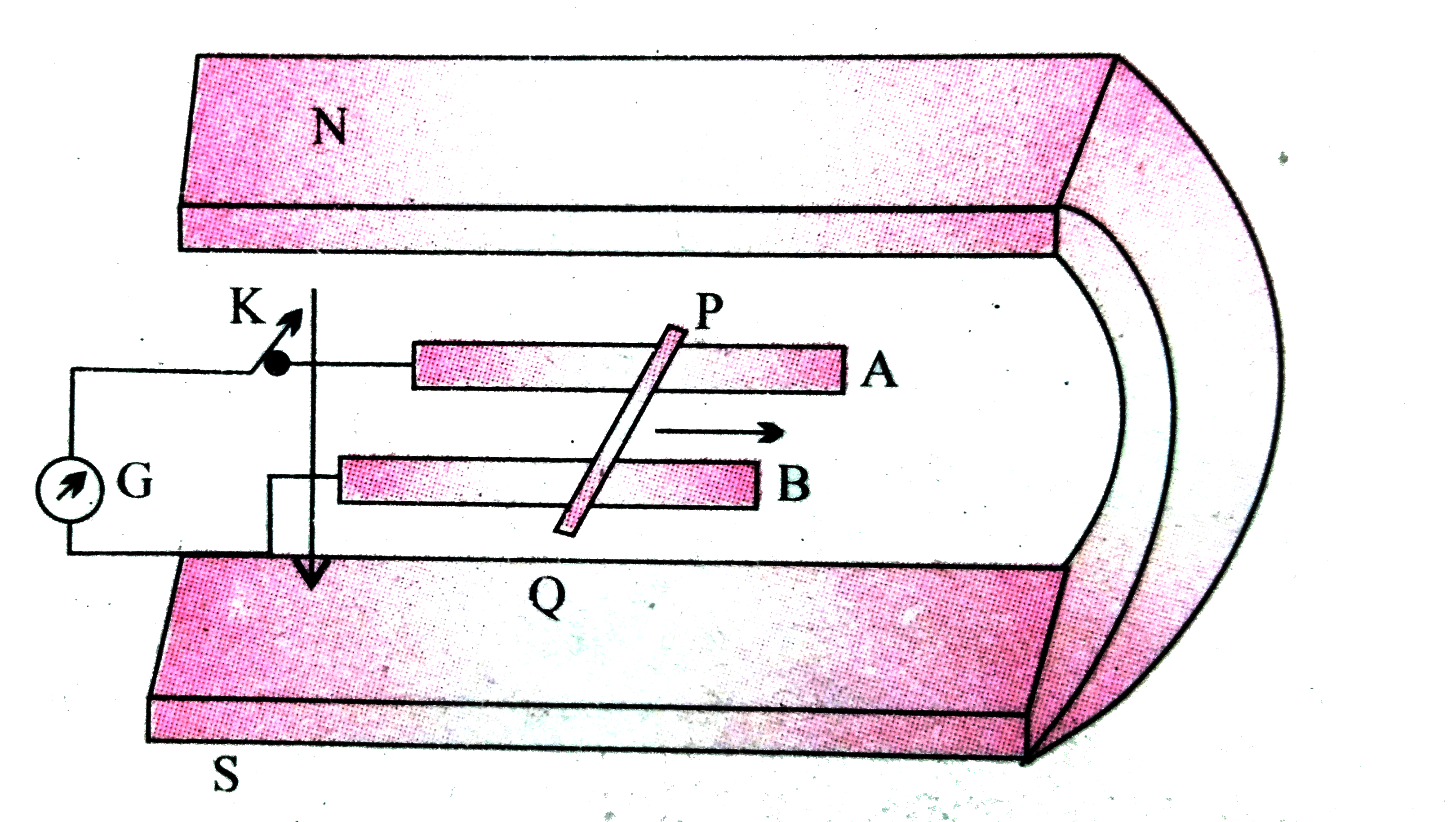
क्या कुंजी K खुली होने पर छड़ के सिरों पर आवेश का आधिक्य हो जायेगा ? क्या होगा यदि कुंजी K बंद कर दी जाए ?
View Solutionचित्र में एक धातु की छड़ PQ को दर्शाया गया है जो पटरियों AB पर रखी है तथा एक स्थायी चुम्बक के ध्रुवो के मध्य स्थित है । पटरियाँ , छड़ एवं चुंबकीय क्षेत्र परस्पर अभिलंबवत दिशाओ में है ।एक गैल्वेनोमीटर ( धारामापी ) G को पटरियों से एक स्विच K की सहायता से संयोजित किया गया है । छड़ की लम्बाई 15 सेमी , B = 0.50 T तथा पटरियों , छड़ धारामापी से बने बंद लूप का प्रतिरोध = 9.0mΩ है । क्षेत्र को एकसमान मान ले ।
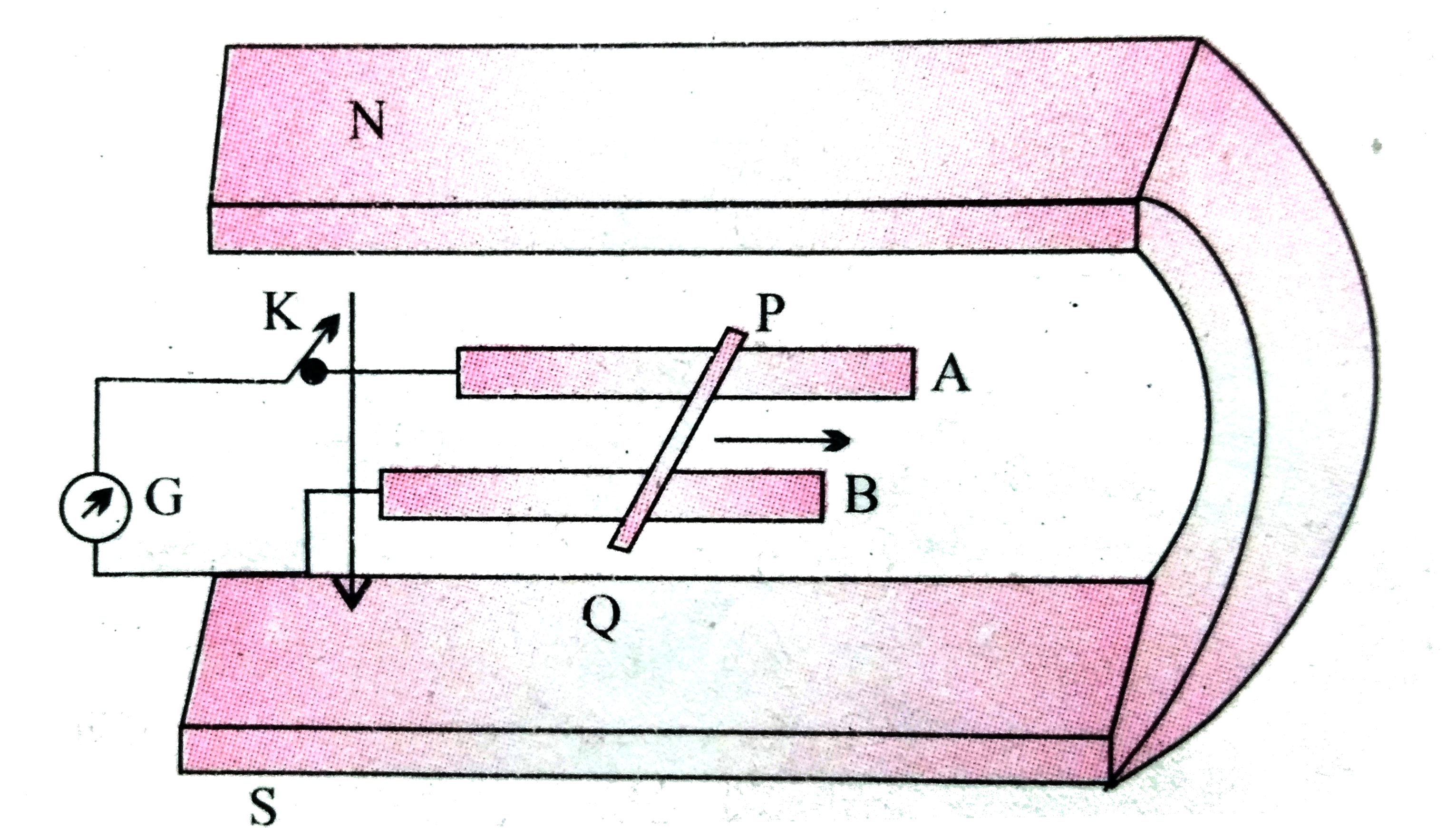
कुंजी बंद है तथा छड़ 12 सेमी /से की चाल से दर्शायी गयी दिशा में गतिमान होने की स्थिति में छड़ पर लगने वाले अवमंदन बल का मान क्या होगा ?
View SolutionA metal rod PQ is resting on the rails A'B' and positioned between the poles of a permanent magnet. The rails, the rod and the magnetic field are in three mutually perpendicular directions. A galvanometer G connects the rails through a switch K. Length of the rod = 15 cm, B = 0.50 T, resistance of the closed loop containing the rod = 9.0 mOmega . Assume the field to be uniform. Suppose K is open and the rod is moved with a speed of 12 cm. s^(-1) in the direction shown. Give the polarity and magnitude of the induced emf.
View SolutionA metal rod PQ is resting on the rails A'B' and positioned between the poles of a permanent magnet. The rails, the rod and the magnetic field are in three mutually perpendicular directions. A galvanometer G connects the rails through a switch K. Length of the rod = 15 cm, B = 0.50 T, resistance of the closed loop containing the rod = 9.0 mOmega . Assume the field to be uniform. Is there an excess charge built up at the ends of the rods when K is open? What if K is closed?
View SolutionA metal rod PQ is resting on the rails A'B' and positioned between the poles of a permanent magnet. The rails, the rod and the magnetic field are in three mutually perpendicular directions. A galvanometer G connects the rails through a switch K. Length of the rod = 15 cm, B = 0.50 T, resistance of the closed loop containing the rod = 9.0mΩ. Assume the field to be uniform.
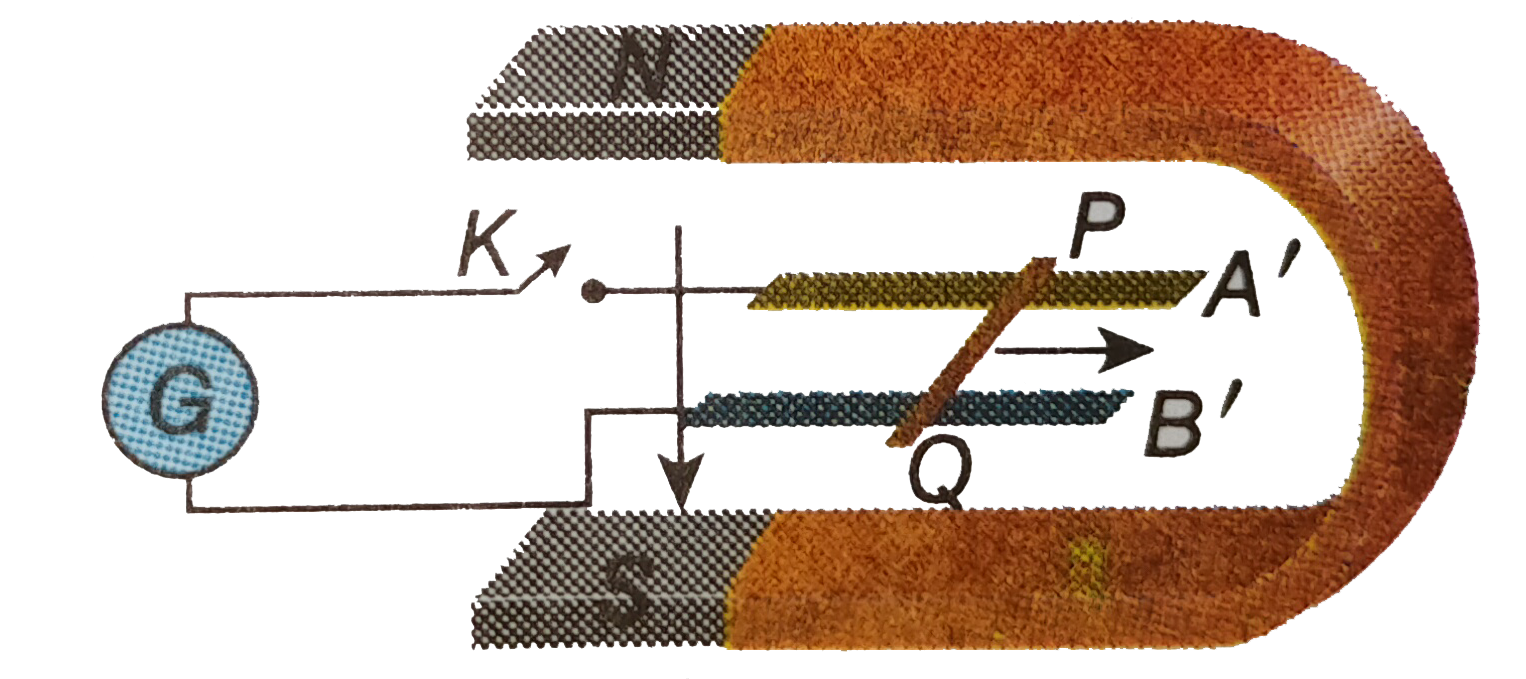
With K open and the rod moving uniformly, there is no net force on the electrons in thr rod PQ even though they do experience magnetic force due to the motion of the rod. Explain.
View SolutionA metal rod PQ is resting on the rails A'B' and positioned between the poles of a permanent magnet. The rails, the rod and the magnetic field are in three mutually perpendicular directions. A galvanometer G connects the rails through a switch K. Length of the rod = 15 cm, B = 0.50 T, resistance of the closed loop containing the rod = 9.0 mOmega . Assume the field to be uniform. How much power is required by an external agent to keep the rod moving at the same speed (=12cm.s^(-1)) when K is closed? How much power is required when K is open?
View SolutionFigure 6.20 shows a metal rod PQ resting on the smooth rails AB and positioned between the poles of a permanent magnet. The rails, the rod, and the magnetic field are in three mutual perpendicular directions. A galvanometer G connects the rails through a switch K. Length of the rod =15 cm, B = 0.50 T, resistance of the closed loop containing the rod=9.0mΩ Assume the field to be uniform. Suppose K is open and the rod is moved with a speed of 12cms−1 in the direction shown. Give the polarity and magnitude of the induced emf. :
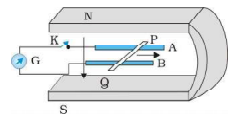
View Solution
